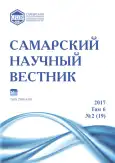Peculiarities of optimal structure of Orenburg Region agrolandscapes
- Authors: Evstifeeva T.A.1, Glukhovskaya M.Y.1
-
Affiliations:
- Orenburg State University
- Issue: Vol 6, No 2 (2017)
- Pages: 35-40
- Section: 03.02.00 – General Biology
- URL: https://journals.rcsi.science/2309-4370/article/view/21793
- DOI: https://doi.org/10.17816/snv201762107
- ID: 21793
Cite item
Full Text
Abstract
In this article the examines the degree of change of regional territories is examined with predominance of earth of the agricultural setting. In the Orenburg Region where in a number of administrative regions more than one third of the territory is plowed, necessity such the researches obvious. The analysis of the distribution of the land fund by category is carried out. Time changes in all land categories were studied, and the level of anthropogenic transformation was determined by the coefficient of land use, the coefficient that takes into account the intensity of agricultural land use and the coefficient of plowing of agricultural lands. A number of disproportions are formed in accordance with the maximum possible and optimal environmental parameters: a large agro-land plot (88,5%, with a norm for steppe zones of 60-65% and an optimal 40%), a lot of arable land (more than 50%, 40-45%), an extremely low proportion of forest land (5,16% in 10-15% and the optimal value of 15-20%), as well as a general lack of natural lands (OOP 0,19-0,64%). Undertaken studies testify to intensive development of agrolandscapes on territory of area, and necessity of artificial maintenance of the equilibrium state of agroecosystems, that can be arrived at only by totality of reclamative, agronomical and ecological events.
Full Text
##article.viewOnOriginalSite##About the authors
Tatyana Aleksandrovna Evstifeeva
Orenburg State University
Email: ta_evst@mail.ru
candidate of agricultural sciences, associate professor of Ecology and Nature Management Department
Russian FederationMarina Yuryevna Glukhovskaya
Orenburg State University
Author for correspondence.
Email: commarina97@mail.ru
сandidate of technical sciences, associate professor of Ecology and Nature Management Department
Russian FederationReferences
- Айдаров И.П. Обустройство агроландшафтов России. М.: МГУП, 2007. 312 с.
- Bucek A. Ecological stability and ecological stress in environmental geography [Ekologicka stabilita a ekologicky stres v geografii zivotniho prostredi]: Sbornik Praci - 1988. CSAV 18. P. 69-75.
- Bucek A., Ungerman J. Complete land reformations in the territory of the productional-organisational unit Merin and agricultural utilization of the landscape. [Souhrnne pozemkove upravy na uzemi vyrobne organizacni jednotky Merin a zemedelske vyuzitikrajiny]: Zpravy Geografickeho - Ustavu Csav. 1978. 15 (6-7). P. 93-104.
- Buček A., Lacina J. Supraregional territorial system of landscape-ecological stability of the former Czechoslovakia: Ekologia Bratislava. 1996. 15 (1). P. 71-76.
- Masný M., Zaušková L. Multi-temporal analysis of an agricultural landscape transformation and abandonment (Lubietová, Central Slovakia): Open Geosciences. 2015. 7 (1). P. 888-896.
- Государственный доклад «О состоянии и об охране окружающей среды Оренбургской области» / Под общей редакцией министра природных ресурсов, экологии и имущественных отношений Оренбургской области. 1992-2015 гг.
- Земельный Кодекс Российской Федерации от 25 октября 2001 г. № 136-ФЗ. Ст. 77: [в ред. от 03.07.2016 г.] // Собрание законодательства Российской Федерации. 2001. № 44. С. 4147.
- Чибилев А.А. Географический атлас Оренбургской области. Оренбург: Оренбургское книжное издательство, 1999. 95 с.
- Глуховская М.Ю., Евстифеева Т.А. Анализ устойчивости региональных территорий (на примере отдельного района Оренбургской области) // Материалы всерос. науч.-метод. конф. 2016. С. 779-785.
- Глуховская М.Ю. Анализ экологической устойчивости и стабильности региональной территории на примере Оренбургской области // Вестник ОГУ. 2017. № 4. С. 53-60.
- Moyzeova M., Kenderessy P. Territorial systems of ecological stability in land consolidation projects (example of proposal for the lses of klasov village, slovak republic): Ekologia Bratislava. 2015. 34 (4). P. 356-370.
- Jurko А. Übersicht über die pflanzengesellschaften des cynosurion-verbandes in den karpaten: Vegetatio. 1969. Vol. 18. Issue 1. P. 222-223.
- Jurko A., Peciar V. Pflanzengesellschaften an schattigen felse en westkarpaten: Vegetatio Acta Geobotanica. 1963. Vol. 11. Issue 4. P. 199-209.
- Voloscuk I. Ecological stability in the Tatra mountains forests: Ekologia Bratislava 1998. 17(1). P. 39-48.
- Zaušková L. Landscape-ecological interpretation and applications of landscape survey results for optimal land use: Ekologia Bratislava. 2014. 33 (3). P. 252-258.
- Supuka J., Uhrin P. Share of scattered woody vegetation in landscape ecological stability and agriculture sustainability: Folia Oecologica. 2016. 43 (2), P. 193-203.
- Блохин Е.В. Экология почв Оренбургской области: почвенные ресурсы, мониторинг, агроэкологическое районирование. Екатеринбург: УрОРАН, 1997. 228 с.
Supplementary files









